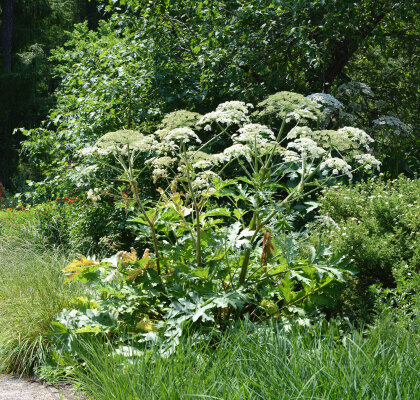Giant Hogweed
Heracleum mantegazzianum
<
>


 Type
Type Plant: INNS
Plant: INNS Status
Status Invasive
Invasive Common
Common Widespread
Widespread Season
Season Spring
Spring Summer
Summer Look out for this invasive non-native plant along the towpath edges, particularly along certain stretches such as between Abermule and Newtown, and whatever you do don't touch it!
Giant Hogweed may belong to the same family as some of our well-known umbellifers, such as parsley and carrot, but this large growing plant originates from Central Asia and was introduced to the UK as an ornamental species in the 19th century.
These days it can be found all over Wales, especially colonising canal towpaths and riverbanks, where its seeds are distributed by the water.
Resembling an enormous Cow Parsley, Giant Hogweed can reach heights of 1.5m to 5m, and a spread of 1-2m when fully grown.
During its first year it forms a rosette of jagged, lobed leaves before sending up a flower spike in its second year and then setting seed. Its flowers are clustered on large, umbrella-shaped flower heads.
As well as outcompeting native flora and spreading aggressively, Giant Hogweed's sap can cause burns. It contains a chemical which makes skin extremely sensitive to sunlight, causing bad blistering that can recur over months and even years. To stay safe, avoid walking through, brushing past or making any contact with Giant Hogweed, especially exposing yourself to plants which might have been cut. If you do happen to get the sap on your skin, wash the area immediately, seek medical advice and don't expose the affected area to sunlight for several days.
Plant stems are hollow, ridged and green with purple blotches and stiff white hairs. Leaves are huge, up to 1.5m and 3m long, with irregular and jagged edges and a hairy underside. Flowers, which appear in June and July, are small and white (sometimes slightly pink) and clustered on umbrella-like heads, known as umbels, facing upwards. Giant Hogweed could be confused with Common Hogweed (Heracleum sphondylium) but the latter is much smaller with less jagged, more rounded leaves.


